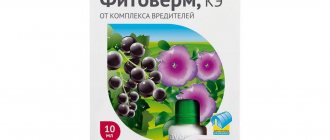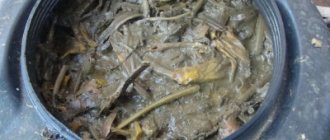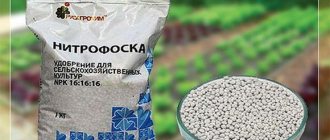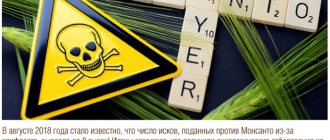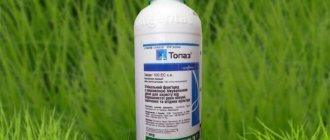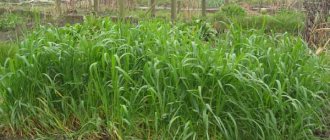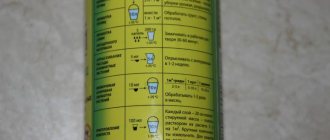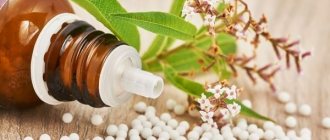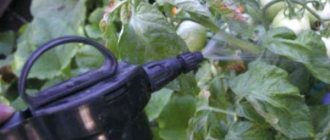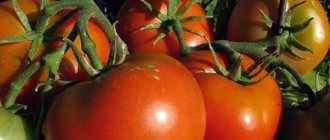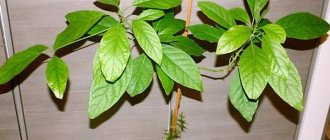Chemical characteristics and purpose of glyphosate
Glyphosate is an organophosphorus compound. It appeared in the mid-twentieth century thanks to the work of the American scientist John Franz. Glyphosate is based on acids and synthesized compounds that have strong hebricidal properties.
Chemical formula: C3H8NO5P. Another name is N-(phosphonomethyl)-glycine. The drug consists of white crystals, is odorless, and dissolves well in water.
Glyphosate controls weeds
The chemical properties of the drug are classified as:
- herbicide;
- desiccant;
- arboricide.
Storage period and conditions
The herbicide can be stored in unopened factory containers for no more than 5 years. The agrochemical should be kept in a separate, dark, dry, ventilated room. The optimal temperature regime for preserving the properties of the drug is from -1 ˚С to 30 ˚С.
Glyphosate is an excellent alternative to mechanical methods of eliminating self-seeding on the site. However, before use, you should familiarize yourself with the features of the drug. To achieve the desired effect without harm to health, you must strictly follow the instructions on the package.
Types of weeds sensitive to the product
Glyphosate kills a large number of plant and shrub species. These include:
Annual weeds:
- annual bluegrass;
- woodlice;
- common cross;
- shepherd's purse;
- Speedwell Persian.
Perennial weeds:
- dandelion officinalis;
- blunt-leaved sorrel;
- horsetail;
- common warbler;
- creeping wheatgrass;
- field thistle.
The drug is effective against many weeds
Advantages and disadvantages:
Pros:
- The ability to quickly get rid of unnecessary vegetation, as it has a continuous effect and affects all plants that are on the site.
- It is highly effective in controlling annual and perennial weeds.
- Low price.
- Has disinfection and deratization properties (destroys the Colorado potato beetle, rats, mice, etc.)
Minuses:
- High toxicity.
- Disturbance of soil microflora.
- Negative consequences of its use.
Interesting Facts
- According to Professor Charles Benbrook, glyphosate is the most widely used herbicide in the world.
- Glyphosate has been used in the fight against narcotic substances. With the help of this herbicide, coca crops were controlled in Colombia.
- The first time we learned about the new glyphosate drug was in 1970. Then the international company Monsanto patented the invention until 2000. The first continuous herbicide was Roundup. After the patent expired, other crop protection companies began releasing their own versions.
- The name "Roundup" refers to the circle of wagons through which the Americans shot at the Indians.
- In 1987, the person who discovered this compound received a National Medal.
Glyphosate kills all weeds. The soil for winter crops is prepared using glyphosate preparations in August-September, and for spring crops it is possible both in the fall and in the spring, before sowing or before germination. Glyphosate can be used as a desiccant. With a no-till system, the soil is not treated with traditional plowing or minimum tillage.
Mechanical treatment prevents the appearance of weeds. Soil that has not been mechanically treated needs to be treated with glyphosates, otherwise the plot of land will become overgrown with weeds. When cultivating the soil, you should follow the application instructions in order to get the result you need.
Tilling the land correctly is an art. When I worked as an agronomist, we were able to destroy persistent wheatgrass only with the help of glyphosate treatment. Such drugs have advantages and disadvantages, choose what is right for you.
Glyphosate-based herbicides
Preparations developed on the basis of glyphosate:
- "Ground";
- "Zeus";
- "Liquidator";
- "Napalm";
- "Roundup";
- "Typhoon";
- "Tornado";
- "Tornado BAU";
- "Clean garden".
To destroy perennial weeds, a more concentrated aqueous solution of a chemical is used than against annual weeds.
Experienced gardeners say that if glyphosate “Tornado”, “Typhoon”, “Liquidator” and others are used carefully and only when necessary, then this is a very effective drug, and there is little harm from it.
The drug is used very carefully
Rules of application:
There are specific instructions for use and dosage of glyphosate herbicide:
- It is better to use the drug in calm weather, otherwise the pesticide cloud will drift away, it will fall on the cultivated plant and lead to its damage.
- For better destruction, the height of the weeds should be 10-20 cm. Treat the weeds with a slot sprayer at minimal pressure. It is important that the drops are large.
- Glyphosate is used in the dosage: 1-2 liters of the drug per 200 liters of water/hectare.
According to the instructions for use, the herbicide “Glyphos” can be used in autumn and spring. In the spring, in order to avoid undesirable consequences, it is necessary to perform mechanical tillage of the field after applying the herbicide no earlier than 3-4 weeks later. If the weather turns bad - cold, rain or drought, the time frame for killing weeds may be extended. The drug itself disintegrates in the soil after two months.
Dosage calculation and consumption rate
The dosage of the herbicide is selected according to the type of weed, the density of the weed and the timing of development. Approximate norms for different types of crops:
| Culture | Volume of Glyphosate in liters per hectare | Deadlines |
| Vineyards, gardens | 2-4 annual weeds 4-8 perennial | Spring-early summer with protection of cultural plantings |
| Potato | 2-3 | Before germination |
| Fields for cereals, vegetables, oilseeds, melons | 2-4 annual weeds 4-8 perennial 6-8 persistent perennials | After harvesting, 2-4 weeks before sowing During active weed growth |
| Desiccation of grains | 2-3 | 14 days before cleaning |
When spraying from the ground, the consumption is 100-200 liters of the finished mixture per hectare, when spraying by air - 50-100 liters per hectare.
Period of protective action
Do you use folk signs in gardening?
Annual weeds are completely killed by glyphosate, but this drug has no effect on seeds. Young weeds may emerge from the seeds.
The instructions for using glyphosate note that perennial rhizomes cannot recover during the growing season, and with high spray rates they are completely destroyed.
Even if a tree that gets a little of the drug does not die, the roots inside the cut may be dead. In the future, this seedling will suffer for a long time and good results will not be expected from it.
Advantages of the product
Glyphos has proven itself well due to the fact that it softens water and contains a high-tech surfactant. The herbicidal properties of the drug are enhanced and no longer depend on weather conditions, as well as the quality of the water in which it is dissolved. The weed killer is also concentrated. This means that transport and storage costs are reduced.
Glyphos has a number of other advantages that you need to know about when choosing a drug.
Advantages:
- One hundred percent result when used.
- The effect of the drug will be as stable as possible, even if after treatment the weeds are exposed to rain or other precipitation.
- There is no risk of pet poisoning.
Varieties and uses of sorghum, how to cook
The composition of the drug is harmful to harmful plants, and the manufacturers guarantee the high quality of the product. The drug can be effectively combined with tank mixtures, as well as with herbicides included in the group of phenoxy acids and sulfonylureas.
Impact speed
Vegetation treated with herbicide dies within a month. Stopping growth and development, as well as signs of damage on annual weeds begins after 2-5 days, on perennial weeds - after 7-30 days.
Vegetation treated with herbicide dies within a month
Possibility of resistance
Although glyphosate is considered a very effective weed killer, its effectiveness has gradually decreased due to the emergence of plants resistant to it. This occurs when the same herbicide is used continuously over several years.
Glyphosate-resistant plants:
- sagebrush;
- burdock;
- St. John's wort;
- common warbler;
- broadleaf cattail.
Among the tree species, it is worth noting coniferous trees.
What is glyphosate
Glyphosate or N-(phosphonomethyl)-glycine was patented as a herbicide in 1970 by the American company Monsanto Co as a result of the work of John Franz - he discovered a completely new mechanism of action of FOS on plants at that time, as a result of which the synthesis of the amino acids phenylalanine, tyrosine and tryptophan was disrupted , necessary for the construction of proteins. This made it possible to introduce the “spray and forget” practice of weed control, but then no one paid attention to the fact that weeds were actually destroyed at the genetic level - there was no reason.
Chemical formula of glyphosate and active ingredients of plant protection products based on it
Pure glyphosate is a white crystalline substance with a density of 1.704 cubic meters. cm, melting point 184.5 degrees Celsius, decomposing already at 187 degrees; its chemical formula is given on the left in Fig. In preparations, plant protection products are used in the form of potassium salt (center) and isopropylamine salt (right). In the latest modifications, diammonium phosphonomethylglycine, trimesium and trimethylsulfonium are also used as salt-forming “makeweights”. The second indispensable component of plant protection products with glyphosate is a surfactant (surfactant) polyoxyethyleneamine (POEA), which facilitates the penetration of the active substance into plant tissue. The translaminar activity of glyphosate is quite high - at temperatures above +15 Celsius, it quickly saturates the entire root and vegetative systems of the plant and it dies. How the effect of glyphosate manifests itself externally, see video:
Video: the effect of glyphosate on plants
The effect of glyphosate is indiscriminate: it kills both weeds and beneficial plants. In the manufacturers' guidelines they modestly write something like: “Selective subject to protection.” That is, cultivated plants must be wrapped in film, and then the weeds must be selectively treated with glyphosate. This already calls into question its applicability in small areas - isn’t regular weeding simpler?
Glyphosate is more selective on plant species: it acts most strongly on cereals, then on dicotyledons and other monocotyledons. Glyphosate is not very effective against conifers; this immediately attracted the attention of foresters to him. In general, the range of particularly harmful and harmful weeds affected by glyphosate is very wide, see figure:
Weeds Killed by Glyphosate
Safety and toxicity
Glyphosate belongs to the 3rd class of hazard substances, due to the fact that its contact with the skin can cause skin cancer; when working with the drug, you should strictly use a full set of personal protective equipment with a gas mask, both in large quantities over large areas and in procedure for weed control in small areas.
The harm to humans from glyphosate is not limited to the immediate effects. The persistent carcinogenicity of this substance in nature makes the long-term consequences of its use, which are still terrifying, even more terrible. Glyphosate is otherwise called a weapon of mass destruction of people and livestock.
The high biological activity of glyphosate is manifested in the fact that it destroys all living things, becoming a serious threat to humanity. By killing beneficial soil microbes, it gradually turns living soil into dead soil.
Scientists have come up with a means to destroy agricultural pests, but it turned out that they not only kill weeds, but also have a very detrimental effect on humans. There is even such a thing as farmer's disease, which is common among gardeners and gardeners who use toxic glyphosate on their plots.
The remains of this substance in nature move with water and enter the human body. Even in pregnant women who have never been exposed to glyphosate, it causes genetic abnormalities in the fetus.
Glyphosate is toxic to humans
Also, this substance causes such severe and irreversible diseases as:
- infertility in men and women;
- the birth of children with genetic mutations (hermaphroditism, dwarfism, dementia);
- hormonal imbalance in children during puberty;
- tumor formation;
- severe eye irritation;
- birth of children with autism;
- liver disease, kidney disease.
Every year, farmers spray millions of liters of glyphosate onto their fields, poisoning humanity for years to come. Some EU countries are planning to phase out this chemical in the near future. A number of retail chains have removed gardening products containing glyphosate and products grown using the drug from their shelves.
Five countries have banned the use of glyphosate in their country:
- Malta;
- Sri Lanka;
- Netherlands;
- Argentina;
- Belgium.
Chinese manufacturers produce the most glyphosate – 70% of all products.
In the Russian Federation, 80% of land is treated with glyphosate, which naturally has a negative impact on the health of Russians.
The only way out is not to buy fruits and vegetables grown by farmers. But city dwellers who do not have their own vegetable gardens are forced to purchase them at risk to their health.
Precautionary measures
The main question for the farmer was: is glyphosate harmful to humans? Still open. Despite the low toxicity (hazard class 3), recent studies show adverse effects on the human body. This is not to say that the drug affects everyone unfavorably.
But recent experiments have shown: 8-9% of people who used Glyphosate have health problems. It is difficult to say whether they were provoked precisely by the main ingredients.
Some countries have imposed a moratorium on use. But in the post-Soviet countries it is allowed. At the same time, experts strongly recommend remembering: it is better to comply with the protection conditions.
Glyphosate is an irreplaceable thing in the household. Only he will help remove the remnants of the harvested crop and weeds.
It is important that in this way plants are protected from fungi and parasitic microorganisms. After all, the drug actively fights fungal spores and other diseases that are located on the soil surface
